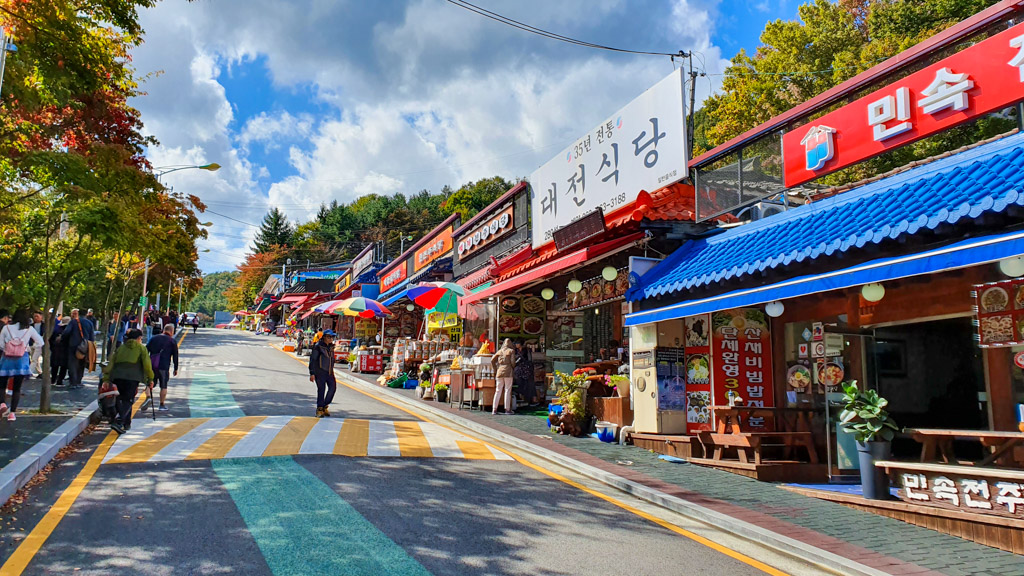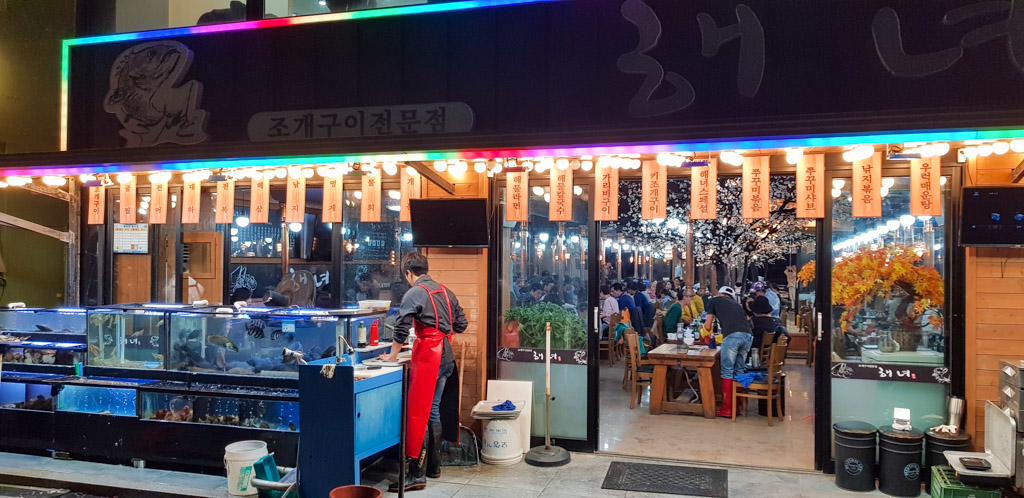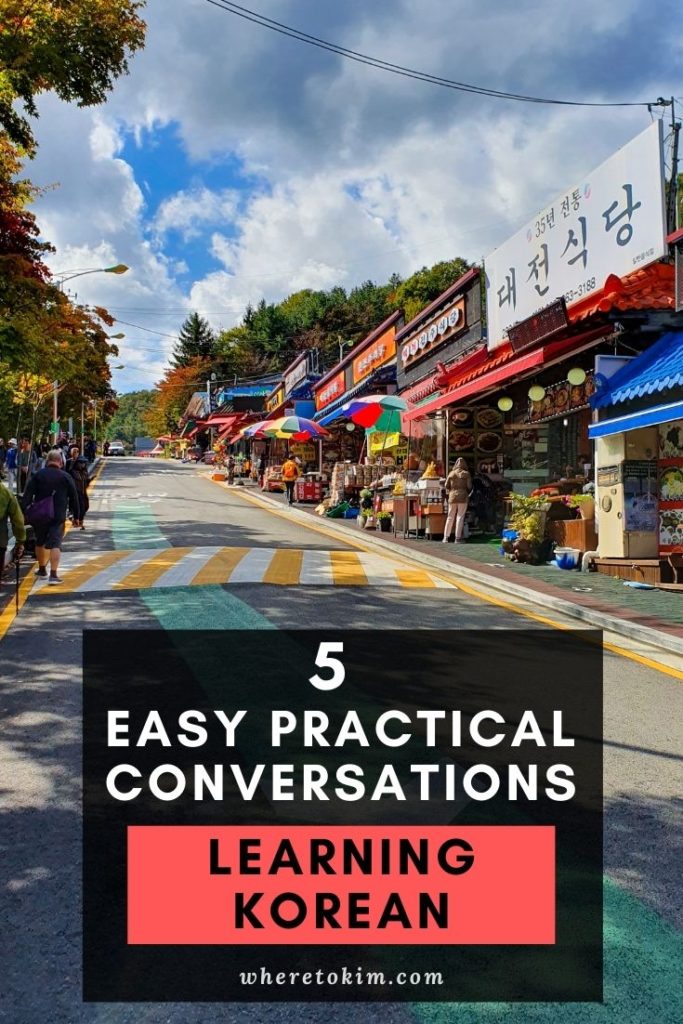Easy Practical Korean Conversations you can try in everyday situations on your trip to South Korea. Make Koreans understand you in no time.
Perfect Korean sentences contain more words, but that is not what you’re going to use at your first attempts at conversation. What you need are the practical parts of the sentences, the triggers, so to say, which will help Korean people understand you if your pronunciation is a bit off.
My tip for you: stick to the basics. You can make your sentences pretty towards the end of your trip. Focus on communicating and getting your message across. It doesn’t matter if they don’t understand you the first time, just try again with the next person you meet. The less English they speak, the more willing (or adept at) they are to understand your Korean phrases.
And if nothing works, you can always resort to pointing and raising your eyebrows. The universal non-verbal language.
These practice conversations are meant for those who already have some basic knowledge of Korean. The expressions used are based on what I have heard Koreans say around me in all these situations.
1) Asking the price
- 이거 얼마예요? (igeo eolmayeyo?)
- 이만 삼천원 (iman samcheon-won; 23000)
- 감사합니다 (gamsahamnida)
Let’s break this down word by word.
How much is this thing? If the object is further away you can replace 이거 by 그거 (far from you near the listener, for example behind the counter) or 저거 (far from both of you). 얼마 means ‘how much’ and 예요 comes from the verb ‘to be’.
Pay attention to the first words of their response. This will be the number you need to process in your head. You can slowly repeat the number out loud to give yourself time to think. The shopkeeper can correct you if you didn’t hear it right. This might be hard at first, but you’ll get the hang of it after a few days. In the example: two (이) times ten thousand (만) and three (삼) times thousand (천) won (원). Pay attention to 만, 천, 백 (hundred) and 원 so you can chop the number into pieces.
Be polite when thanking the seller with 감사합니다. Unless you have a five-year-old kid in front of you in which case you can be less formal and say 고마워.

2) Buying tickets
- 세명 주세요 (semyeong juseyo)
At a ticket booth, you can order tickets by telling the salesperson the number of people in your group. For me, it was 세명 as I usually bought three tickets. For two it would be 두명. Add 주세요 for more politeness.
They’ll respond with the amount you need to pay, but it might be easier to find the individual ticket price at the information board near the counter. You can also just hand over one or more 10k won bills if you are lazy.
3) Saying how big your group is when entering a restaurant
- They ask: 몇분? (myeotbun?)
- Your answer: 두명 (dumyeong)
They’ll politely ask you how big your group is using the polite people counter 분. When replying you use the less polite counter 명 as the more formal one shouldn’t be used when talking about yourself.
4) Ordering food
4a) Full order
- 불고기 하나 순두부 하나 소주 하나 밥 두개 주세요 (bulgogi hana sundubu hana soju hana bab dugae juseyo)
This is just an example. If you say the above you will order one bulgogi, one sundubu, one soju and two bowls of rice. You can also point at the menu and say 이거 하나 for every picture or menu item you point at.
Of course, you can use more words to create a more textbook sentence (like using 하고 or (이)랑 in between), but this already works great wherever you go.
In theory, you should use different counters for bowls of food (그릇), glasses (잔) and bottles (병) etc. but make it easier for yourself and just use the general counter 개 for everything.
If you’re with two other people and they ask if you want three bowls of rice (세개) you can say 두개 if you only want two.
Also read: Best Textbooks for Learning Korean
4b) Asking for something else
- 불고기가 없어요 (bulgogi-ga obseoyo)
- 삼겹살 있어요? (samgyeobsal isseoyo?)
They might reply to your order by saying a menu item is not available (없어요). You can then reply by asking if they have something else – even something that’s not on the menu – with 있어요 in order to replace your original order.
Even when you visit a fish-only restaurant, you can always try asking for meat. Many restaurants can serve bulgogi, samgyeobsal, or tteokgalbi on the side.

4c) Confirming your order
- 네 / 아니요 (ne / aniyo)
Servers at a restaurant will often repeat your order to you. You can reply with 네 if it is correct or 아니요 if it isn’t.
4d) Adding something to your order
- 저기요 소주 하나 주세요 (jeogiyo soju hana juseyo)
- 네 (ne)
You can add another item to your order by first calling for attention with 저기요. Once they are at your table, or if it is quiet at the restaurant you can just ask for the extra item as soon as they look at you. They’ll confirm your order – in this example one soju (소주 하나) – with a short 네 or by immediately bringing it to your table.
5) Saying where you’re from
- Country answer: 네덜란드 (nedeollandeu)
- How long does it take to fly from your country to South Korea: 열 시간 (yeol sigan)
It helps if you formulate your answer and look up the words before the first Korean person has a chance to ask you this question.
Nearly every day some random person would ask me where I came from. Too unprepared to answer with a full sentence … (or rather too scared to raise their expectations) I would answer with the name of my country 네덜란드 (Netherlands). This was usually followed by an expression of ‘wow, that’s far’ and the question how long it takes to fly to South Korea from there. Ten hours (열 시간); that’s how long it takes in the most optimal direction.
Looking back at my trip, these were the Korean conversations I had most often. And with that I mean nearly every day, all five of them, sometimes multiple times a day. If you master these five situations, you will gain enough confidence to speak Korean on your trip to South Korea.







